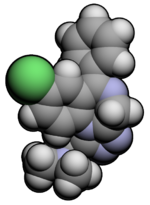Adinazolam
 |
|
 |
|
| Systematic (IUPAC) name | |
|---|---|
|
1-(8-Chloro-6-phenyl-4H-[1,2,4]triazolo[4,5-a][1,4]benzodiazepin-1-yl)-N,N-dimethylmethanamine
|
|
| Clinical data | |
| Routes of administration |
Oral |
| Legal status | |
| Legal status |
|
| Pharmacokinetic data | |
| Metabolism | Hepatic |
| Biological half-life | < 3 hours |
| Excretion | Renal |
| Identifiers | |
| CAS Number | 37115-32-5 |
| ATC code | N05BA07 (WHO) |
| PubChem | CID 37632 |
| DrugBank | DB00546 |
| ChemSpider | 34519 |
| UNII | KN08449444 |
| KEGG | D02770 |
| ChEBI | CHEBI:251412 |
| ChEMBL | CHEMBL328250 |
| Chemical data | |
| Formula | C19H18ClN5 |
| Molar mass | 351.8 |
| 3D model (Jmol) | Interactive image |
|
|
|
|
| (verify) | |
Adinazolam[1] (marketed under the brand name Deracyn) is a benzodiazepine derivative, and more specifically, a triazolobenzodiazepine (TBZD). It possesses anxiolytic,[2] anticonvulsant, sedative, and antidepressant[3][4] properties. Adinazolam was developed by Dr. Jackson B. Hester, who was seeking to enhance the antidepressant properties of alprazolam, which he also developed.[5] Adinazolam was never FDA approved and never made available to the public market, however it has been sold as a designer drug.[6]
Contents
Side effects[edit]
Overdose may include muscle weakness, ataxia, dysarthria and particularly in children paradoxical excitement, as well as diminished reflexes, confusion and coma may ensue in more severe cases.[7]
A human study comparing the subjective effects and abuse potential of adinazolam (30 mg and 50 mg) with diazepam, lorazepam and a placebo showed that adinazolam causes the most "mental and physical sedation" and the greatest "mental unpleasantness".[8]
Pharmacodynamics and pharmacokinetics[edit]
Adinazolam binds to peripheral-type benzodiazepine receptors that interact allosterically with GABA receptors as an agonist to produce inhibitory effects.
Metabolism[edit]
Adinazolam was reported to have active metabolites in the August 1984 issue of The Journal of Pharmacy and Pharmacology.[9] The main metabolite is N-desmethyladinazolam.[10] NDMAD has an approximately 25-fold high affinity for benzodiazepine receptors as compared to its precursor, accounting for the benzodiazepine-like effects after oral administration.[1] Multiple N-dealkylations lead to the removal dimethyl-aminoethyl side chain, leading to the difference in its potency.[10] The other two metabolites are alpha-hydroxyalprazolam and estazolam.[11] In the August 1986 issue of that same journal, Sethy, Francis and Day reported that proadifen inhibited the formation of N-desmethyladinazolam.[12]
See also[edit]
References[edit]
- ^ a b FR Patent 2248050
- ^ Karthik Venkatakrishnan; Lisa L. Von Moltke; Su Xiang Duan; Joseph C. Fleishaker; Richard I. Shader; David J. Greenblat (March 1998). "Kinetic Characterization and Identification of the Enzymes Responsible for the Hepatic Biotransformation of Adinazolam and N-Desmethyladinazolam in Man". Journal of Pharmacy and Pharmacology. 50 (3): 265–274. doi:10.1111/j.2042-7158.1998.tb06859.x. PMID 9600717.
- ^ Dunner D, Myers J, Khan A, Avery D, Ishiki D, Pyke R (June 1998). "Adinazolam-A New Antidepressant: Findings of a Placebo-Controlled, Double-Blind Study in Outpatients with Major Depression.". Journal of Clinical Psychopharmacology. 7 (3): 170–172. PMID 3298327.
- ^ Lahti, Robert A.; Vimala H. Sethy; Craig Barsuhn; Jackson B. Hester (November 1983). "Pharmacological profile of the antidepressant adinazolam, a triazolobenzodiazepine.". Neuropharmacology. 22 (11): 1277–82. doi:10.1016/0028-3908(83)90200-9. PMID 6320036.
- ^ "Discovers Award 2004" (PDF). Special Publications. Pharmaceutical Research and Manufacturers of America. April 2004. p. 39. Archived (PDF) from the original on August 24, 2006. Retrieved August 18, 2006.
- ^ Moosmann, Bjoern; Bisel, Philippe; Franz, Florian; Huppertz, Laura M.; Auwärter, Volker (2016). "Characterization and in vitro phase I microsomal metabolism of designer benzodiazepines – an update comprising adinazolam, cloniprazepam, fonazepam, 3-hydroxyphenazepam, metizolam, and nitrazolam". Journal of Mass Spectrometry. doi:10.1002/jms.3840. ISSN 1096-9888. PMID 27535017 – via Wiley Online Library.
- ^ "Adinazolam". DrugBank.
- ^ M. Bird; D. Katz; M. Orzack; L. Friedman; E. Dessain; B. Beake; J. McEachern; J. Cole (1987). "The Abuse Potential of Adinazolam: A Comparison with Diazepam, Lorazepam and Placebo" (PDF). NIDA Research Monograph No. 81.
- ^ Sethy, Vimala H.; R. J. Collins; E. G. Daniels (August 1984). "Determination of biological activity of adinazolam and its metabolites.". Journal of Pharmacy and Pharmacology. 36 (8): 546–8. doi:10.1111/j.2042-7158.1984.tb04449.x. PMID 6148400.
- ^ a b Peng, G. W. (August 1984). "Assay of adinazolam in plasma by liquid chromatography". Journal of Pharmaceutical Sciences. 73 (8): 1173–5. doi:10.1002/jps.2600730840. PMID 6491930.
- ^ Fraser, A. D.; A. F. Isner; W. Bryan (November–December 1993). "Urinary screening for adinazolam and its major metabolites by the Emit d.a.u. and FPIA benzodiazepine assays with confirmation by HPLC". Journal of Analytical Toxicology. 17 (7): 427–31. doi:10.1093/jat/17.7.427. PMID 8309217.
- ^ Sethy, Vimala H.; Jonathan W. Francis; J. S. Day (August 1986). "The effect of proadifen on the metabolism of adinazolam". Journal of Pharmacy and Pharmacology. 38 (8): 631–2. doi:10.1111/j.2042-7158.1986.tb03099.x. PMID 2876087.